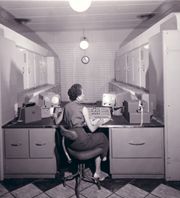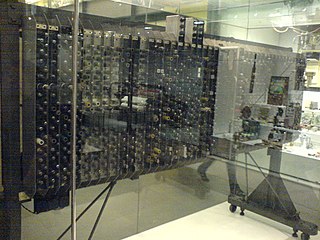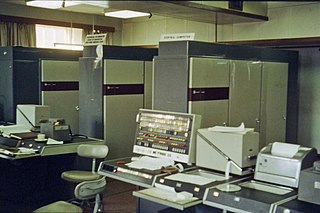Related Research Articles

The Atanasoff–Berry computer (ABC) was the first automatic electronic digital computer. The device was limited by the technology of the day. The ABC's priority is debated among historians of computer technology, because it was neither programmable, nor Turing-complete. Conventionally, the ABC would be considered the first electronic ALU – which is integrated into every modern processor's design.

The history of computing hardware spans the developments from early devices used for simple calculations to today's complex computers, encompassing advancements in both analog and digital technology.

The Williams tube, or the Williams–Kilburn tube named after inventors Freddie Williams and Tom Kilburn, is an early form of computer memory. It was the first random-access digital storage device, and was used successfully in several early computers.

Whirlwind I was a Cold War-era vacuum-tube computer developed by the MIT Servomechanisms Laboratory for the U.S. Navy. Operational in 1951, it was among the first digital electronic computers that operated in real-time for output, and the first that was not simply an electronic replacement of older mechanical systems.

The IBM 700/7000 series is a series of large-scale (mainframe) computer systems that were made by IBM through the 1950s and early 1960s. The series includes several different, incompatible processor architectures. The 700s use vacuum-tube logic and were made obsolete by the introduction of the transistorized 7000s. The 7000s, in turn, were eventually replaced with System/360, which was announced in 1964. However the 360/65, the first 360 powerful enough to replace 7000s, did not become available until November 1965. Early problems with OS/360 and the high cost of converting software kept many 7000s in service for years afterward.

The Manchester Baby, also called the Small-Scale Experimental Machine (SSEM), was the first electronic stored-program computer. It was built at the University of Manchester by Frederic C. Williams, Tom Kilburn, and Geoff Tootill, and ran its first program on 21 June 1948.

The Ferranti Mark 1, also known as the Manchester Electronic Computer in its sales literature, and thus sometimes called the Manchester Ferranti, was produced by British electrical engineering firm Ferranti Ltd. It was the world's first commercially available electronic general-purpose stored program digital computer.

The Pilot ACE was one of the first computers built in the United Kingdom. Built at the National Physical Laboratory (NPL) in the early 1950s, it was also one of the earliest general-purpose, stored-program computers – joining other UK designs like the Manchester Mark 1 and EDSAC of the same era. It was a preliminary version of the full ACE, which was designed by Alan Turing, who left NPL before the construction was completed.
The APE(X)C, or All Purpose Electronic (X) Computer series was designed by Andrew Donald Booth at Birkbeck College, London in the early 1950s. His work on the APE(X)C series was sponsored by the British Rayon Research Association. Although the naming conventions are slightly unclear, it seems the first model belonged to the BRRA. According to Booth, the X stood for X-company.

Pegasus was an early British vacuum-tube (valve) computer built by Ferranti Ltd that pioneered design features to improve usability for both engineers and programmers. It was originally named the Ferranti Package Computer as its hardware design followed that of the Elliott 401 with modular plug-in packages. Much of the development was the product of three men: W. S. (Bill) Elliott (hardware), Christopher Strachey (software) and Bernard Swann. It was Ferranti's most popular valve computer with 38 units being sold. The first Pegasus was delivered in 1956 and the last was delivered in 1959. Ferranti received funding for the development from the National Research Development Corporation (NRDC).
The MUSASINO-1 was one of the earliest electronic digital computers built in Japan. Construction started at the Electrical Communication Laboratories of NTT at Musashino, Tokyo in 1952 and was completed in July 1957. The computer was used until July 1962. Saburo Muroga, a University of Illinois visiting scholar and member of the ILLIAC I team, returned to Japan and oversaw the construction of MUSASINO-1.

Elliott Brothers (London) Ltd was an early computer company of the 1950s and 1960s in the United Kingdom. It traced its descent from a firm of instrument makers founded by William Elliott in London around 1804. The research laboratories were originally set up in 1946 at Borehamwood and the first Elliott 152 computer appeared in 1950.

The Elliott 803 is a small, medium-speed transistor digital computer which was manufactured by the British company Elliott Brothers in the 1960s. About 211 were built.

The Atlas was one of the world's first supercomputers, in use from 1962 to 1972. Atlas's capacity promoted the saying that when it went offline, half of the United Kingdom's computer capacity was lost. It is notable for being the first machine with virtual memory using paging techniques; this approach quickly spread, and is now ubiquitous.

The Manchester computers were an innovative series of stored-program electronic computers developed during the 30-year period between 1947 and 1977 by a small team at the University of Manchester, under the leadership of Tom Kilburn. They included the world's first stored-program computer, the world's first transistorised computer, and what was the world's fastest computer at the time of its inauguration in 1962.

The Manchester Mark 1 was one of the earliest stored-program computers, developed at the Victoria University of Manchester, England from the Manchester Baby. Work began in August 1948, and the first version was operational by April 1949; a program written to search for Mersenne primes ran error-free for nine hours on the night of 16/17 June 1949.

The EMIDEC 1100 computer was produced by the Computing Services Division of EMI Laboratories in the UK under the leadership of Godfrey Hounsfield in 1958, after one year's development. It used magnetic-core memory and transistor technologies and it is claimed to be the first large commercial transistorised machine in the UK.

The IBM Naval Ordnance Research Calculator (NORC) was a one-of-a-kind first-generation computer built by IBM for the United States Navy's Bureau of Ordnance. It went into service in December 1954 and was likely the most powerful computer at the time. The Naval Ordnance Research Calculator (NORC), was built at the Watson Scientific Computing Laboratory under the direction of Wallace Eckert.

A vacuum-tube computer, now termed a first-generation computer, is a computer that uses vacuum tubes for logic circuitry. While the history of mechanical aids to computation goes back centuries, if not millennia, the history of vacuum tube computers is confined to the middle of the 20th century. Lee De Forest invented the triode in 1906. The first example of using vacuum tubes for computation, the Atanasoff–Berry computer, was demonstrated in 1939. Vacuum-tube computers were initially one-of-a-kind designs, but commercial models were introduced in the 1950s and sold in volumes ranging from single digits to thousands of units. By the early 1960s vacuum tube computers were obsolete, superseded by second-generation transistorized computers.
The Elliott 503 was a transistorized computer introduced by Elliott Brothers in 1963. It was software-compatible with the earlier Elliott 803 but was about 70 times faster and a more powerful machine. About 32 units were sold. The basic configuration had 8192 words of 39 bits each for main memory, and operated at a system clock speed of 6.7 megahertz. It weighed more than 4,050 pounds.
References
- ↑ Lavington, Simon Hugh (1980). Early British Computers: The Story of Vintage Computers and the People who Built Them. Manchester University Press. pp. 57–58. ISBN 9780719008108.
- ↑ Simon Lavington, Moving Targets: Elliott-Automation and the Dawn of the Computer Age in Britain, 1947 – 67, Springer Science & Business Media, 2011, ISBN 1848829337 pp. 58-62